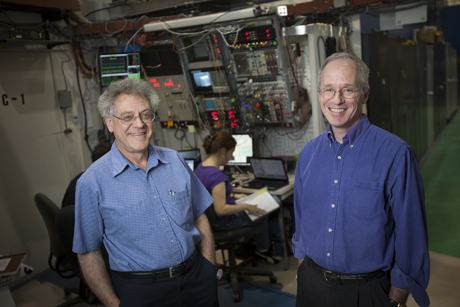'Living vicariously' has marked Gruner's time at CHESS
By Anne Ju

As director of the Cornell High Energy Synchrotron Source (CHESS) for not quite 17 years, Sol Gruner takes pride not only in his own science but in the successes of countless others, which are often the result of techniques and instrumentation that only CHESS can provide.
On July 1, Gruner will step down as director of CHESS, continuing as Cornell’s John L. Wetherill Professor of Physics. He will be succeeded by Joel Brock, professor of applied and engineering physics.
“You have to learn to live vicariously,” said Gruner, 62. “You’re enabling other people to be able to do science, which is fantastic. In some sense that’s what CHESS is all about.”
A National Science Foundation (NSF)-supported user facility, CHESS is a high-intensity X-ray source that facilitates research in physics, chemistry, biology and materials science.
Case in point: Rod MacKinnon of Rockefeller University won the 2003 Nobel Prize in chemistry for his work on the structure of ion channels. Using a detector that Gruner’s research group built for CHESS, and director’s discretionary beam time, MacKinnon did research in the late 1990s that garnered the Nobel, Gruner said.
Gruner’s own scientific contributions are many. He and a former graduate student, Chae Un Kim, Ph.D. ’08, developed a technique called pressure freezing that Kim continues to improve as a staff scientist at MacCHESS, the macromolecular diffraction facility at CHESS. Gruner will stay on as co-principal investigator of MacCHESS.
Gruner is also looking forward to having more time to dedicate to his graduate students and his physics department lab. His research interests lie in developing novel instrumentation to uncover the structure and function of proteins and the development of novel materials.
Looking back, Gruner notes that a lot of CHESS science blooms from personal interactions. For instance, a fruitful relationship has formed between art restorers and X-ray scientists who peer beneath painted-over canvasses with confocal X-ray microscopy. That collaboration started because Gruner’s former postdoc, Adam Finnefrock, is married to former chemistry Ph.D. student Jennifer Mass, who is an art restoration expert.
Gruner’s time at CHESS has also been distinguished by change: Around 2000, he led a major expansion of the G line, with three new beam lines added. In 2006 CHESS and the Laboratory for Elementary Particle Physics merged to form the Cornell Laboratory for Accelerator-Based Sciences and Education (CLASSE).
Also throughout Gruner's tenure, many CLASSE researchers undertook experiments, prototyping and analysis to demonstrate the feasibility of building an Energy Recovery Linac (ERL) X-ray facility. Started about 12 years ago, the ERL project would redesign the synchrotron source, extending its capabilities and that of the Cornell Electron Storage Ring (CESR) to produce the world’s most powerful X-ray beams.
“We’ve had incredible success with the ERL [research and development] program, which was designed to demonstrate all the key critical technologies to build the ERL,” Brock said. “We have gone significantly beyond what we thought was possible.”
The ERL project now awaits improvement in the fiscal climate for building new, large national facilities. In the meantime, a series of upgrades for CHESS and CESR could be in the facility’s near-term future under Brock’s leadership. These would include improvements to beam lines to increase spectral brightness, and the reconfiguration of the storage ring for optimization of X-ray production.
“I am hoping for continued upgrade and transformation of the lab,” Brock said. “Directing the lab over the next couple of years toward new X-ray equipment and instrumentation I think can really transform the place.”
Brock praised Gruner’s leadership of CHESS, which is undergoing its five-year NSF grant renewal process; the current award finishes in March 2014.
“Sol has been very good at identifying and attracting really high-quality talent both in terms of our employees and scientists but also in terms of external collaborators and people who use the place,” Brock said. “When you think about all the things you want a director to do, from new capital equipment to new facilities, to hiring great staff and attracting world-class collaborators … what else could you possibly imagine? And he did it for 17 years.”
Media Contact
Get Cornell news delivered right to your inbox.
Subscribe